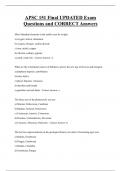APSC 151 Final UPDATED Exam
Questions and CORRECT Answers
Most Abundant elements in the earth's crust by weight
a) oxygen, silicon, aluminum
b) oxygen, nitrogen, carbon dioxide
c) iron, nickel, copper
d) calcium, sodium, gypsum
e) earth, wind, fire - Correct Answer- A
What are the 2 dominant sources of lithium to power the new age of devices and transport
a) porphyry deposits, astroblemes
b)veins, dykes
c) placer deposits, volcanoes
d) rhyolites and basalts
e) granitites and salt lakes - Correct Answer- e
The three eras of the phanerozoic eon are:
a) Silurian, Ordovician, Cambrian
b) Hadean, Archean, Proterozoic
c) Cretaceous, Jurassic, Cretaceous
d) Permian, Carboniferous, Devonian
e) Cenozoic, Mesozoic, Paleozoic - Correct Answer- E
The last two supercontinents in the geological history (in order of increasing age) were
a) Rodina, Gondwana
b) Pangea, Gondwana
c) Rodina, Columbia
d) Gondwana, Pangea
,e) Ur, Arctica - Correct Answer- D
Grand Lake in Newfoundland and Loch Ness in Scotland are deep lakes filling an ancient
fault valley that was directly connected before
a) The formation of the St, Lawrence Rift
b) The Appalachian Orogeny
c) The Rupture of the San Andreas Fault
d) The rifting of the modern Atlantic Ocean
e) The creation of the Ottawa Graben - Correct Answer- D
Iceland is unique in the world in that it is located on both a
a) subduction trench and a transform fault
b) a porphyry and kimberlite
c) a diverging boundary and a hot spot
d) a pluton and a hot spot
e) a magmatic deposit and and a astrobleme - Correct Answer- C
One of the catalysts that promoted the formation of complex organic molecules and RNA
were
a) cyanobacteria
b) subduction zones
c) montmorillonite clay
d) volcanic eruptions
e) abiotic methane - Correct Answer- C
Archaea differ from bacteria in that they were typically
a) smaller
b) photosynthetic
c) extremophiles
d) organic
e) found with nuclei - Correct Answer- C
,For the first billion years of oxygen generation, the oxygen was used up
a) by archaea
b) by cyanobacteria
c) concentration alumina into bauxite
d) precipitating iron oxide from the oceans
e) photosynthesizing - Correct Answer- D
The Permian period ended with a mass extinction caused by an asteroid impact giving rise to
the age of the
a) mammals
b) amphibians
c) trilobites
d) carbon forests
e) dinosaurs - Correct Answer- E
Which of the following is not a defining characteristic of a mineral
a) inorganic composition
b) solid state
c) ordered internal structure
d) well-defined external shape
e) naturally-occurring - Correct Answer- D
Order the chemical bonding types in order of increasing bond strength
a) ionic, van de vaals, covalent
b) metallic, ionic, covalent
c) van der vaals, ionic, covalent
d) metallic, hydrous, oxide
e) covalent, metallic, fusion - Correct Answer- B
Characteristics of calcite that make it ideal as an abrasive in toothpaste include
, a) double refraction, ionic bonding
b) triple cleavage, low hardness
c) white streak, low specific gravity
d) pearly luster, high hardness
e) double refraction, high hardness - Correct Answer- B
Examples of intrusive igneous features or formations are:
a) lapilli tuffs and pyroclastic
b) aa pahoehoe
c) laccoliths and dykes
d) plutons and ignimbrites
e) volcanic breccias and kimberlites - Correct Answer- c
Mount Vesuvius is a composite cone that has
a) typically low viscosity flowing lava eruptions
b) aa and pahoehoe
c) intermixed lava flows and explosive flowing lava eruptions
d) primarily ash eruptions
e) steaming fumaroles and cinder - Correct Answer- D
The Laki Fires of 1783-1784 was a major volcanic eruption in Iceland that created ______
that caused _______ and led to the __________.
a) lava flows, forest fires, conquest of the Vikings
b) earthquakes, landslides, increase of Iceland's landmass
c) a huge ash cloud, crop failure in Europe, French Revolution
d) a tsunami, widespread flooding, death of millions
e) pyroclastic flows, the burial of villages, mass migration out of Iceland - Correct Answer- C
Which of the following is not a natural hazard normally associated with volcanic eruptions
a) ash fall
b) lava flows




